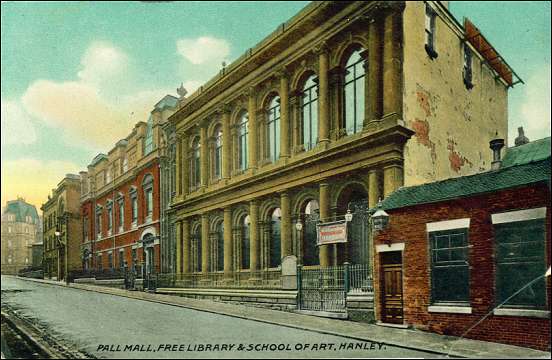|

This
picture looks up Pall Mall towards Albion Street
the Town Hall can be seen on the left of the picture at the
very end of Pall Mall
On the right the first large imposing
building was the Museum and further up the road was the free public
library. Both these buildings were demolished in the early 1970's.

“Although it’s a deserted street now Pall Mall was once a busy place
housing a large number of important public buildings like the library,
the central museum, the School of Art, the Mechanics Institution and the
Theatre Royal,” he says. “Hanley people were so proud of the spacious
and well paved streets lined with elegant public offices that they named
them after London locations, Pall Mall, Cheapside and Piccadilly. Early
maps show Pall Mall to be a much wider thoroughfare than its neighbours.
It travelled straight from the town hall in Albion Square across
Piccadilly into Marsh Street. It’s where the civic fathers chose to
quarter the buildings that defined Hanley’s cultural status.”
This then was the cultural quarter of Victorian Hanley. In addition to
Steve’s list of civic buildings the Theatre Royal stood out as a special
place. Today it’s a nightclub and bears no resemblance to its former
incarnation as Stoke on Trent’s premier playhouse where queues snaked
around the corner to see classical and popular shows.
“The Theatre Royal had a chequered life,” says Steve. “Built in 1871 it
replaced an existing playhouse in Brunswick Street known as the Royal
Theatre and People's Hall. This theatre was considered dingy and
inconvenient so they built the new one facing into Pall Mall with the
stage door in Brunswick Street. It was enlarged in 1888 and partially
reconstructed in 1894. Then it famously burnt down in 1949 when the
Sadler’s Wells Ballet Company was performing here. After a couple of
years lying derelict it was rebuilt. But fashions change. By the 1960’s
it had become a Bingo Hall and in 1981 that closed. However it was
rescued for a short time in 1997 opening for its last spell as a theatre
under the management of local entrepreneur Mike Lloyd. But it was a
short-lived venture.”
These days many of the imposing buildings along the south side of the
grand mock-Regency street have been demolished. Some have been replaced
by mismatched expediency structures. Others have been replaced by car
parks.
“I think it’s a shame that a car park stands on ground that once housed
these important cultural edifices,” Steve continues. “The Mechanics
Institution was founded originally in nearby Frederick Street to promote
learning among the working classes with lecture rooms, a library of
1,500 books and a science laboratory. All these facilities came under
one roof in the new building in Pall Mall in 1887 when the library was
increased to 8,185 books. Its architecture was impressive to say the
least with neo-classical stone dressings with Doric pillars and
cast-iron railings and gate-piers.” |
![]()
![]()
![]()